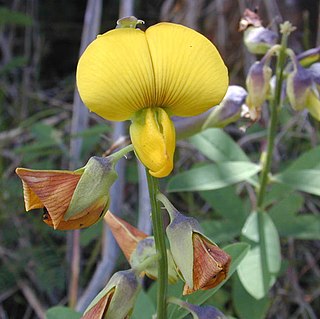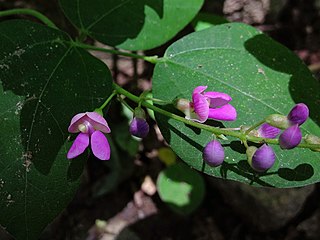
The Faboideae are a subfamily of the flowering plant family Fabaceae or Leguminosae. An acceptable alternative name for the subfamily is Papilionoideae, or Papilionaceae when this group of plants is treated as a family.

Phaseolus is a genus of herbaceous to woody annual and perennial vines in the family Fabaceae containing about 70 plant species, all native to the Americas, primarily Mesoamerica.

Vigna is a genus of plants in the legume family, Fabaceae, with a pantropical distribution. It includes some well-known cultivated species, including many types of beans. Some are former members of the genus Phaseolus. According to Hortus Third, Vigna differs from Phaseolus in biochemistry and pollen structure, and in details of the style and stipules.

The plant tribe Phaseoleae is one of the subdivisions of the legume subfamily Faboideae, in the unranked NPAAA clade. This group includes many of the beans cultivated for human and animal food, most importantly from the genera Glycine, Phaseolus, and Vigna.
Condylostylis is a small genus of flowering plants in the legume family, Fabaceae. It belongs to subfamily Faboideae. The genus includes four species native to the tropical Americas, ranging from southeastern Mexico to northern Argentina. Species in this genus were formerly considered to belong to the genus Vigna.
Dolichopsis is a small genus of flowering plants in the legume family, Fabaceae. It belongs to the subfamily Faboideae. It includes three species native to South America, ranging from west-central and southeastern Brazil to Bolivia, Paraguay, and northern Argentina.

Leptospron is a small genus of flowering plants in the legume family, Fabaceae. It contains two species with a pantropical distribution. It belongs to the subfamily Faboideae. Species in this genus were formerly considered to belong to the genus Vigna.
Mysanthus uleanus is a species of flowering plant in the legume family, Fabaceae. It is a climbing herb endemic to eastern Brazil. It grows in seasonally-dry tropical wooded grassland, thorn scrub, rocky shrubland, and in degraded areas. It is the only described member of the genus Mysanthus, though there is a report of an undescribed species. The genus belongs to subfamily Faboideae.

Oxyrhynchus is a small genus of flowering plants in the legume family, Fabaceae. It includes four species, three native to the tropical Americas from northern Mexico to Colombia, and one native to New Guinea, Maluku, and the Bismarck Archipelago. It belongs to the subfamily Faboideae. A key for the species in this genus has been published.

Sigmoidotropis is a genus of flowering plants in the legume family, Fabaceae. It includes eight species native to the tropical Americas, ranging from northern Mexico and the Caribbean islands to southern Brazil. It belongs to the subfamily Faboideae. Species in this genus were formerly considered to belong to the genus Vigna.

Strophostyles helvola, commonly called amberique-bean, annual sand bean, or trailing fuzzybean is a species of flowering plant in the legume family. It is native to eastern Canada and the eastern United States.

Ancistrotropis is a genus of flowering plants in the legume family, Fabaceae. It belongs to the subfamily Faboideae. Species in this genus were formerly considered to belong to the genus Vigna.

Cochliasanthus caracalla is a leguminous flowering plant in the family Fabaceae that originates in tropical South America and Central America. The species is named caracalla, a corruption of the Portuguese caracol, meaning snail.
Helicotropis is a small genus of flowering plants in the legume family, Fabaceae. It belongs to the subfamily Faboideae. It includes three species of perennial climbing vines native to the tropical Americas, ranging from southern Mexico to northeastern Argentina. Species in this genus were formerly considered to belong to the genus Vigna.

Ramirezella is a small genus of flowering plants in the family Fabaceae. It includes seven species of climbing herbs native to southern North America, ranging from northern Mexico and Nicaragua. Typical habitats include seasonally-dry tropical forest and secondary vegetation in disturbed areas. It belongs to the subfamily Faboideae.

Wajira is a small genus of flowering plants in the legume family, Fabaceae. It belongs to the subfamily Faboideae. Species in this genus were formerly considered to belong to the genus Vigna. A key for the genus has been published.

Strophostyles umbellata, commonly known as the pink fuzzybean or perennialwild bean, is a species of perennial flowering plant in the family Fabaceae. It is native to fields and woods in the southeastern and central United States. It blooms from June to September.

Phaseolus polystachios, also known as the thicket bean or wild kidney bean, is a perennial, herbaceous vine that is native to North America. It is unique among the Phaseolus in that its native range extends across the eastern temperate United States to southeast Canada, while most Phaseolus are tropical or subtropical. It is the namesake for the Polystachios group clade, which is the most species-rich within Phaseolus. In spite of its common name, it is more closely related to the lima bean, and it holds potential as a crop wild relative due to its resistance to white mold.

Strophostyles leiosperma, known as slickseed fuzzybean, or smoothseed / small-flower wildbean is a species of herbaceous, vining legume native to the central to western U.S. It occurs west to Colorado and New Mexico, east to Louisiana, south to Mexico, and north to Minnesota. It is most easily distinguished from the other two Strophostyles species by the abundance of small silky hairs on its leaves and pods, and small pea-shaped flowers with a much reduced keel that is largely hidden by the wing petals.

























